The Xiaomi Mi 11i HyperCharge is a stellar mid-range phone that comes with a staggering 120-watt fast charging speed. To put that in perspective, that’s about five times as fast as the Galaxy S21 and six times faster than the iPhone 13. Naturally, we had to put it to the test to see if it lives up to these lofty expectations.
What phone is this actually?
The Mi 11i is a rebranded Redmi Note 11 Pro Plus (Chinese variant) and was launched in India earlier this month for about $360. Not only is the Mi 11i the fastest charging smartphone available in the market, but Xiaomi also brings the technology to the mid-range instead of limiting it to the premium segment, and that makes it even more attractive.

Notably, the Mi 11i (or the Redmi Note 11 Pro Plus China) is not the first Xiaomi phone to come with 120W fast charging. The flagship-killer Xiaomi 11T Pro unveiled in September 2021 was the first Xiaomi device to sport its 120W technology, which was later also introduced in the flagship segment with the Xiaomi 12 series. At the same time, Vivo’s sub-brand iQOO also offers 120W with the iQOO 7 but limits it to China.
How we tested
For this review, we tested the Xiaomi Mi 11i HyperCharge’s 120W HyperCharge tech and compare its charging performance in four different scenarios as listed below. These scenarios are used to determine the Mi 11i’s resilience against demanding tasks like streaming a 4K HDR video or playing a graphics-intensive game and how they may (or may not) deter the phone’s fast charging. Along with observing how the rate of charging varies with time, we will also take a look at changes in the battery’s temperature to verify Xiaomi’s claims about the key implementations in the charging circuit that make the 120W charging safe for daily usage both to the phone and to the users.
Disclaimer: These tests were performed in winters with an ambient temperature of about 18 Celsius (approximately 65 Fahrenheit). Heat is generated while charging due to energy losses and that, in turn, slows down charging. So, our test may have different results in warmer weather.
Mi 11i HyperCharge/Redmi Note 11 Pro Plus 120W charging test
| Charging Scenario | Time taken from 5% to 50% | Time taken from 5% to 90% | Time taken from 5% to 100% |
| Charging without case | 6 minutes, 8 seconds | 15 minutes, 8 seconds | 19 minutes, 45 seconds |
| Charging with silicon case | 6 minutes, 19 seconds | 16 minutes, 19 seconds | 20 minutes, 50 seconds |
| Charging while watching 4K video at full brightness | 7 minutes, 11 seconds | 17 minutes, 55 seconds | 21 minutes, 38 seconds |
| Charging while playing Genshin Impact | 9 minutes, 6 seconds | 25 minutes, 46 seconds | 30 minutes, 8 seconds |
Charging speed test without a case
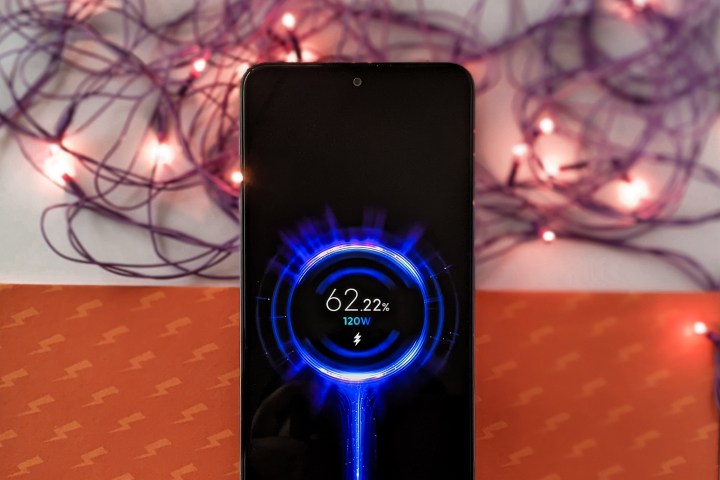
The first test is a charging analysis of the Mi 11i HyperCharge takes into account the general pattern of charging seen with the smartphone. To measure the time taken to charge the 5,000mAh battery using the 120W power brick supplied in the box of the Mi 11i HyperCharge, I used the Battery Log Android app. In the first scenario, the charging rate is tested without using the case supplied with the phone inside the box while the phone is kept untouched for the charging duration.
Xiaomi claims the phone goes from 0% battery charge to 100% in 15 minutes. However, the results are recorded in a controlled test environment inside a laboratory and might not replicate in real-life scenarios. To emulate actual use cases, we kept the phone’s Wi-Fi and Always-On Display (AOD) switched on during the charging duration.
Our test reveals the Xiaomi Mi 11i HyperCharge goes from 5% battery capacity to 90% in a few seconds more than 15 minutes. It takes about 5 more minutes to reach a 100% level of battery charge, bringing the total time to charge the phone from 5% to 100% to about 20 minutes. That may not match up to Xiaomi’s claims but the result is still pretty incredible. You can simply plug the phone into the charger for about 10 minutes and get more than 65% charge, which should last several hours of heavy usage.
Note, the green curve in the graphs below represents the change in battery level over time while the yellow curve represents the change in temperature over time. The Y-axis on the left denotes battery levels while the one on the right denotes temperature in Celcius.
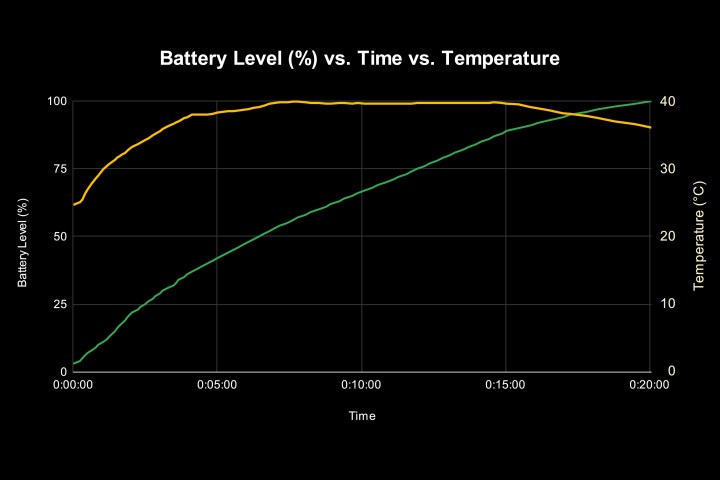
Looking at the variation in the battery’s temperature during the charging test, we see the battery touch a peak temperature of about 40 degrees Celsius (104 degrees Fahrenheit). The temperature at the beginning of the charging is 24 degrees Celsius (75 degrees Fahrenheit) but rises to its peak in just 6 minutes as the battery approaches 50% capacity. The battery temperature begins to decline after 90% as the battery reaches its trickle charge phase. At the end of the cycle, the battery temperature is at 36 degrees Celsius (97 degrees Fahrenheit), which is not unbearably hot, but you may feel the heat if you are using the phone while charging it.
Charging speed test with silicone case
In our next scenario, we study how the Mi 11i HyperCharge charges when we use the clear silicone case that is supplied within the box. This test is important since many users are likely to use cases with their phones to prevent damage due to impact. Since silicone is an insulator of heat, it traps the heat generated during charging and recedes the phone’s ability to radiate it in the atmosphere. Xiaomi is relying on several design elements such as multiple battery cells, a 50-50 split design to keep the heat generation under check.
In our test, we follow the same procedure where we keep the phone’s Wi-Fi and AOD turned on but do not use the phone during the charging period. The temperature of the battery is 3 degrees Celsius (37 degrees Fahrenheit) higher i.e. at 27 degrees Celsius (81 degrees Fahrenheit) with a case on the phone as compared to without it. Despite that, the phone does not exceed the peak temperature in the case above. In fact, it stays cooler by one degree Celcius (34 degrees Fahrenheit) — at 39 degrees Celsius (102 degrees Fahrenheit) at max — even though it approaches the peak relatively earlier, around the 40% mark. Interestingly, we also noticed a quicker decline which begins around 80% charge, with the battery settling at 36 degrees Celsius (97 degrees Fahrenheit) at the end of the test.

In terms of the time taken by the Mi 11i HyperCharge to top up the battery, it goes from 5% to 90% capacity in 16 minutes, taking an extra minute as compared to the previous test. Taking five additional minutes to reach 100%, the Mi 11i HyperCharge completes a battery charge cycle in 21 minutes.
Even though the one-minute difference with and without the case is observable, it will not make any noticeable difference to users in their daily usage. In 10 minutes, the phone charges about 62%.
Charging speed 4K video streaming

Although there is a meager — and therefore, easy to overlook — difference between our first and second tests, the next scenarios subject the Mi 11i HyperCharge to more stress. That is because we charge the phone while streaming a 4K HDR video on YouTube while keeping the display at maximum brightness. Xiaomi claims a typical brightness of 700 nits for the Mi 11i HyperCharge’s AMOLED display so we can expect some battery drain happening at this front. At the same time, the phone is still kept in a case to strain it further.
At the beginning of our charging test, the phone is at 27 degrees Celsius (81 degrees Fahrenheit). It spikes to about 38 degrees Celsius (100 degrees Fahrenheit) when it approaches the 40% mark. It adds additional 2 degrees Celcius (36 degrees Fahrenheit) at 50%, peaking at around 40 degrees Celsius (104 degrees Fahrenheit). Because the display is in use continuously, the phone’s temperature remains at 40 degrees Celsius (104 degrees Fahrenheit) until the battery reaches 92% capacity, after which the trickle charge characteristics result in a slight fall in the temperature. When the battery reaches 100% capacity, it is still at 38 degrees Celsius (100 degrees Fahrenheit), which is slightly hotter than our previous tests.
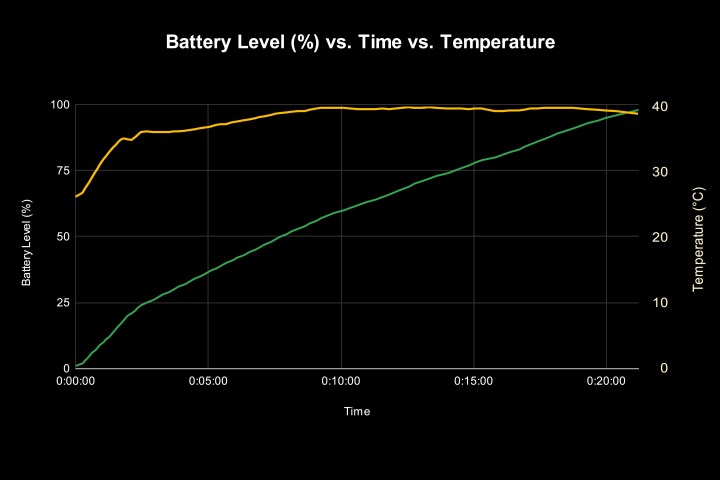
In terms of the time taken, the Mi 11i HyperCharge shoots from 5% to 90% in about 18 minutes and reaches the 100% mark in a few seconds short of 22 minutes. That one more minute from our last test — and two more from the first one — but we would be nitpicking by actually treating it as slow.
The Mi 11i HyperCharge gains about 55% charge in 10 minutes of charging using the 120W brick.
Charging speed gaming

With 120W superfast charging on the Mi 11i HyperCharge, we expect many users to leverage the safeguards put in place by Xiaomi to avoid overheating of the smartphones. This is especially beneficial when you are in the middle of a gaming session and do not want low battery levels to mar your streak. In order to test how well these safeguards keep the Mi 11i HyperCharge from reducing the gaming performance on the smartphone while charging in a jiffy, we play an unrestricted session of Genshin Impact on the phone. Genshin Impact is one of the most graphics-intensive games on Android, which makes it ideal for our testing. Notably, we chose to skip using the case in this test to be able to feel the heat (literally) with the increase in temperature during gaming.
We used GameBench to test how the Mi 11i HyperCharge’s gaming performance changes with combined heat generation due to charging while gaming. Chips including CPU and GPU are coded with throttling algorithms that prevent the system from generating excessive heat during intensive tasks such as gaming. To fend off excessive heat and to prevent temperatures from rising further, these algorithms limit the performance of the CPU and GPU. Using a benchmark tool such as GameBench gives us a fair idea about the throttling due to heat generated while playing the gaming coupled with the heat generated during charging the Mi 11i HyperCharge using the 120W fast charger.
Disclaimer: GameBench gave us a free journalist license for using their tool, which is otherwise paid. Although GameBench helped us with a free license, they did not have any input in this article.
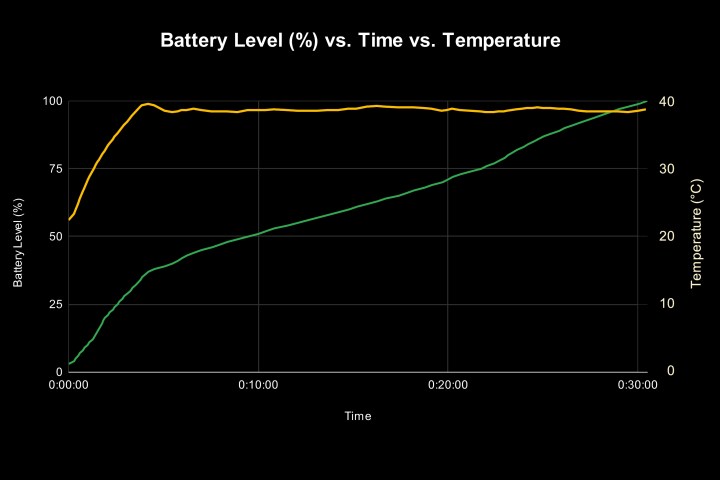
Looking at the variation in temperatures first, the Mi 11i HyperCharge’s battery starts charging at 22 degrees Celsius (72 degrees Fahrenheit) and reaches a peak temperature of 40 degrees Celsius (104 degrees Fahrenheit) in just under four minutes because of the high graphics requirement of Genshin Impact. The temperature float between 39 degrees Celsius (102 degrees Fahrenheit) and 40 degrees Celsius (104 degrees Fahrenheit) until the charging is complete.
Unlike the previous three scenarios where the charging curve was nearly straight (representing an almost steady flow of charge into the battery unaffected by the stressors), the charging rate begins to fall right as the phone hits its peak temperature. This is possibly a preventive measure to avoid excessive heat generation within the charging circuit. The reduced charging rate translates to a longer charging period, with the Mi 11i HyperCharge taking nearly 26 minutes to reach the 90% mark and another five minutes to rake up the remaining charge to complete charging. Therefore, the phone takes a few seconds more than 30 minutes to complete charging while gaming.
Talking about the gaming performance of the Mi 11i HyperCharge, it rendered Genshin Impact at a frame rate varying between 25 and 30 frames per second (fps). There were observable frame rate drops when the warrior used a weapon in a battle, lowering the frame rate to about 15 fps. Furthermore, as the phone got warmer, frame rate drops become more frequent while the Mi 11i HyperCharge’s MediaTek Dimensity 920 chipset equipped with a Mali-G68 GPU struggled with ceaseless stuttering. Although the frame rate drops did not impair the gameplay significantly (because of the open-world single-player nature of the game), they could be infuriating in online and high-paced multiplayer games like PUBG Mobile.
Final verdict
The Mi 11i HyperCharge continues to impress with its superfast charging time in various scenarios. Although the charging takes longer than the time claimed by Xiaomi, we were at peace with the results. Moreover, the excellent heat management was astounding, as the smartphone never breached the 40 degrees Celsius (104 degrees Fahrenheit) mark, even when we played a graphics-intensive game while charging it. Another benefit to the device is that the 120W charger you get inside the box can be used to fast charge other devices. I used it to charge my 13-inch MacBook Pro 2020 and managed to charge it faster than the standard 61W Apple charging brick that came with the laptop, despite the Xiaomi charger being smaller in size.
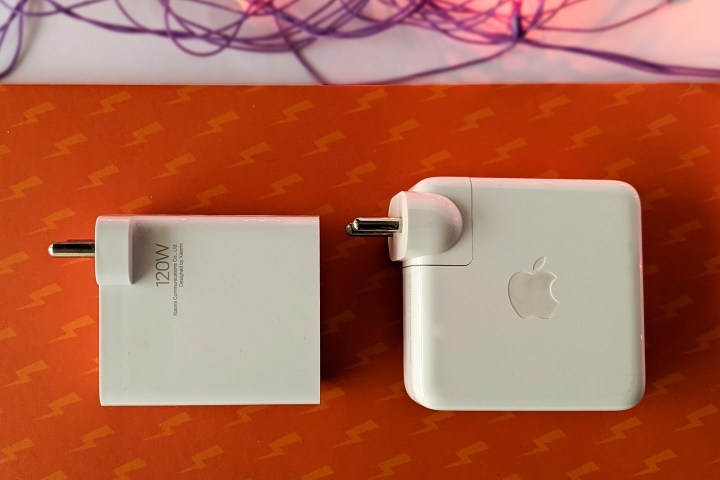
But at the same time, the gaming performance on the Mi 11i HyperCharge suffered considerably when charging, and that may not be acceptable to seasoned mobile gamers. A downside of the excellent heat management was the galling performance throttling on the device. To be fair to Xiaomi, the onus here lies on the mediocre Dimensity 920 but the lesson here is that the smartphone may not be the best choice for gamers.
Is the Xiaomi Mi 11i HyperCharge worth buying?
The Mi 11i HyperCharge is a worthy midrange smartphone and a good competitor to the likes of the Samsung Galaxy A52. Its 108MP triple cameras, pretty colors, and 120W fast charging make it a lucrative device, even though the excessive weight may not be something many would admire. But the device is nowhere close to being positioned as a gaming smartphone, especially if you plan to game and top up the battery at the same time.

The Xiaomi Mi 11i HyperCharge (as well as its twin sibling, Redmi Note 11 Pro Plus) is currently limited to India and China. Do note that Xiaomi also sells another device called (Mi 11i in Europe ), but that is a completely different device that is a victim of Xiaomi’s dumbfounding naming scheme across the different markets it sells smartphones.



